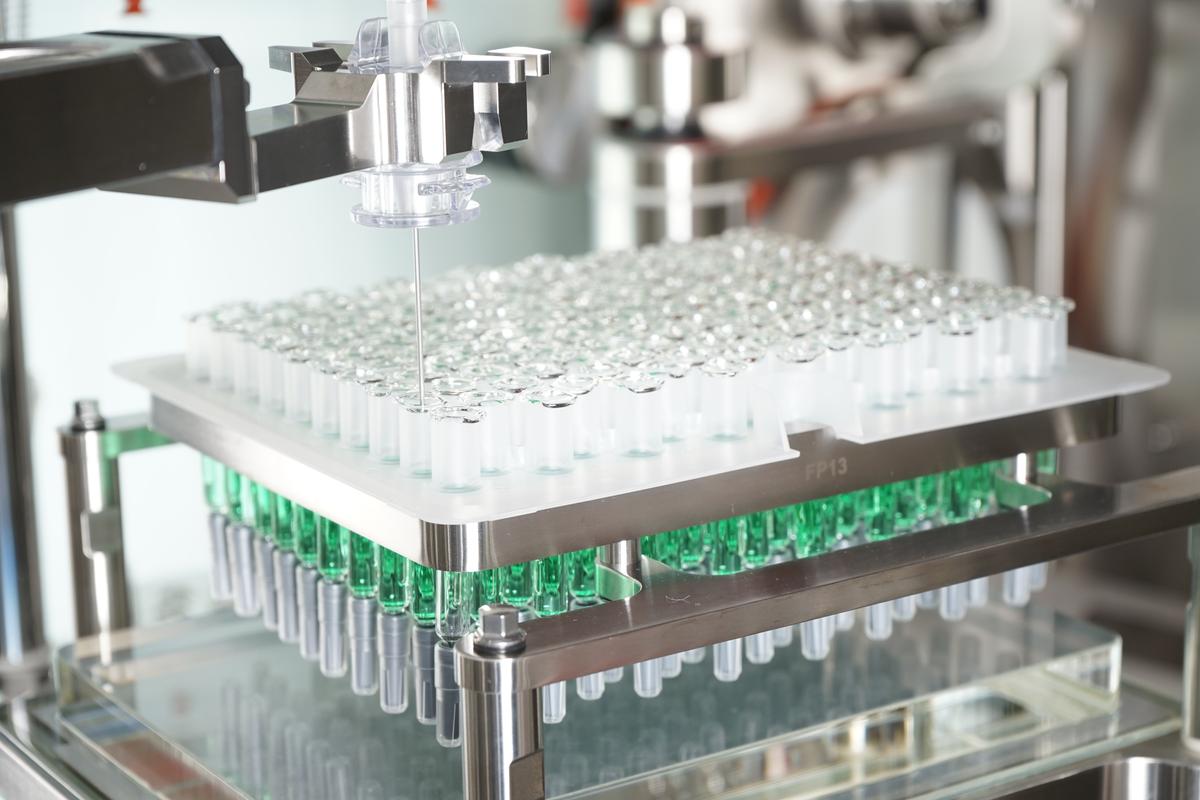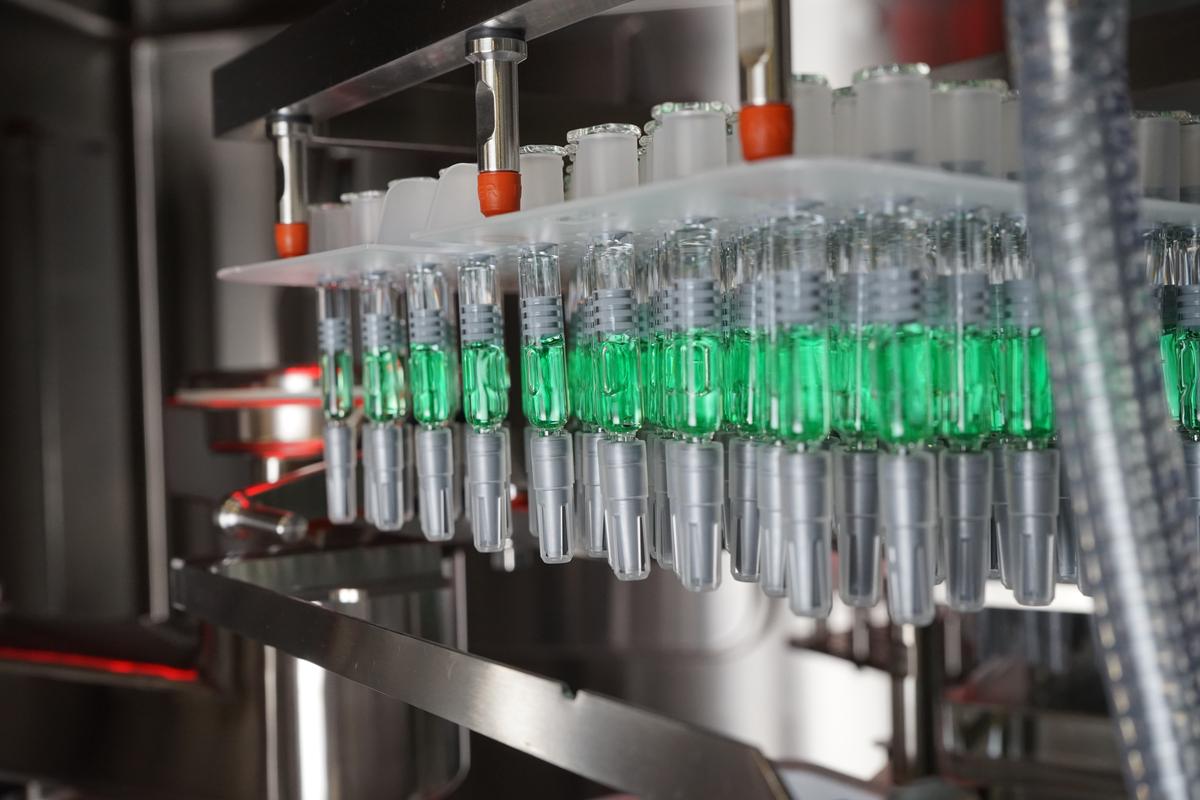Prefilled syringes (PFS) are a well-established drug delivery method for both complex biologics and traditional small molecule drugs. They have many advantages over other container types but present several challenges for syringe fill-finish.
Prefilled syringes have many advantages for the delivery of both complex biologics and small molecule drugs. Compared with traditional syringes, prefilled syringes (PFS) reduce medication errors, allow quick and safe preparation and administration, have long shelf lives, and reduce the risk of overfill. Taken together, these advantages result in smaller batch volumes and lower development costs. However, prefilled syringes can add complexity to the fill-finish process. Read about the challenges companies are experiencing when filling syringes with new complex biologics compared to small molecule drugs.
Fig 1. Robotic filling of nested syringes inside the SA25 Aseptic Filling Workcell.
Traditional plunger placement
Many biologics are manufactured in small batches, quickly. The formulation of the biologics will affect the filling process. In order to avoid issues with drug stability and performance, syringe filling and stoppering requires precise plunger placement.
Traditional methods for syringe filling and stoppering use high-speed equipment to deliver the liquid product into the syringe and perform a stoppering technique called vented placement (slip stoppering). A plunger is placed inside a tube that is then inserted into the syringe body. As the tube is removed from the syringe, a rod will hold the plunger in place. The plunger will then expand to match the diameter of the syringe.
Often, plungers intended for biologic drugs are manufactured with a coating that reduces interactions between the drug and plunger. This creates a disadvantage for slip stoppering as the compression forces applied can cause the coating to wrinkle or tear, resulting in closure leaks and contamination risk. Slip stoppering can also leave an air bubble (headspace) in the syringe between the drug product and plunger. When the syringe is exposed to reduced atmospheric pressure (e.g., during shipping), the air bubble can increase the possibility of plunger movement and potentially pull contaminants into the product. The oxygen in the headspace may also react with some oxygen-sensitive biologics affecting their stability and shelf-life.
Precise bubble-free plunger placement
Although traditional slip stoppering is a common practice, it’s not recommended when manufacturing complex biologics. The options are to reduce the headspace by a bubble-free filling method or reconstitute the headspace with a non-oxygen environment by inert-gas back-fill.
Bubble-free filling accuracy is accomplished by an alternative stoppering technique called vacuum placement. To reduce the air bubble, a vacuum is pulled in each syringe, which causes a differential pressure. This pressure will draw the plunger into the syringe. Vacuum placement doesn’t compress the plungers and leaves minimal headspace between the drug product and plunger. This method eliminates many challenges observed in slip-stoppering and is also preferred for high-viscosity biologics such as ophthalmic medicines. The main issue with this established technology is the difficulty surrounding delivery of reliable and consistent levels of vacuum within the limited amount of time available for the stoppering process. However, machines with mechanical assist and increased control over vacuum levels overcome this obstacle.
The advantages of syringe bubble-free filling for biologics include:
- Dosing accuracy: with the removal of the air bubble, syringe orientation doesn’t affect the dosage delivery to the patient.
- Sterility assurance: decreases the likelihood of plunger movement during shipping and maintains the sterile environment within the syringe.
- Biologic stability: impedes the ability for molecular rearrangements that lead to protein aggregation, resulting in the stability of oxygen-sensitive drugs being maintained.
Fig 2. The SA25 Aseptic Filling Workcell supports the filling of ready-to-use (RTU) nested syringes in multiple sizes and formats.
Auto-injectors
Auto-injectors are medical devices a patient uses to self-deliver a dose of a particular medication. Some auto-injectors use PFS instead of cartridges. In this case the precise placement of the stopper is key. This delivery mechanism is in high demand for use by patients with diseases that affect dexterity and the ability to administer medication with a traditional syringe (e.g., multiple sclerosis or rheumatoid arthritis). The manufacturing process for PFS used in auto-injectors requires a high degree of accuracy and control to create a dependable drug delivery mechanism.
Traditional vibratory bowls vs. ready-to-use nested formats
In traditional fill-finish processes vibratory bowls are used to attain proper orientation of plungers and closures. This requires stringent control over the aseptic process as there are many opportunities for complications to arise. Vibratory bowls introduce particle generation from movement of the bowl itself and the plungers within it. Operator intervention is unavoidable in these systems due to fallen plungers and mandatory vibratory bowl cleaning to reduce, but not eliminate, particles created. This intervention significantly reduces throughput and reduces the sterility assurance of any drug product.
To avoid these challenges, most PFS and corresponding plungers are supplied in a ready-to-use (RTU) nest and tub format. RTU nests are delivered ready for filling, as the sterilization process has already been completed. This system guarantees no glass-to-glass contact, requires no operator intervention due to fallen syringes, has no indirect product contact parts, and dramatically reduces particle generation as vibratory bowls are not used. RTU components provide the enhanced certainty in performance and compatibility of components required by pharmaceutical companies. And with greater certainty, new products or added production capacity can potentially reach the market faster.
Flexible syringe fill-finish machine
A dependable aseptic filling machine needs to provide complete control over the process via precise filling accuracy, stopper placement, vacuum control, and inert gas backfill. The SA25 Aseptic Filling Workcell encompasses all these necessities and provides increased sterility assurance compared with conventional systems.
The SA25 is a gloveless robotic isolator in which the filling and closing process is performed robotically. The standard design allows for the flexibility to change between many nested ready-to-use syringe formats, as well as vials and cartridges. The syringes are filled with the desired drug by way of a recipe-driven control system that enables a repeatable aseptic filling process. Once the fill is complete, the plungers are placed with extreme accuracy through a combination of mechanical placement and precise vacuum control. This method reduces and can eliminate air bubbles inside the syringe, which ensures stability for all drug products. For oxygen-sensitive drugs, an inert gas backfill mechanism can be utilized. The entire production process is predictable and regulated, even when filling and stoppering complex drug products.
Simple and flexible processing formats make syringes easier to incorporate into a pharmaceutical company’s manufacturing line. Cytiva works with leading pharmaceutical packaging suppliers making ready-to-use tub formats of pre-sterilized syringes to integrate flawlessly to the aseptic filling process. Such suppliers include ARaymond, Daikyo Seiko, Datwyler Group, Ompi, Schott AG, Schott Kaisha, and SiO2 Medical Products.
Last Updated: July 15, 2022

